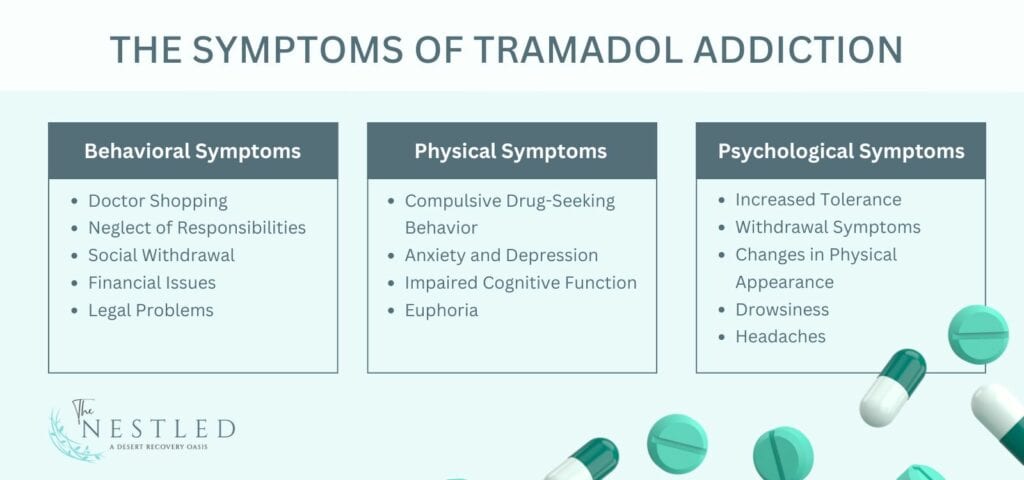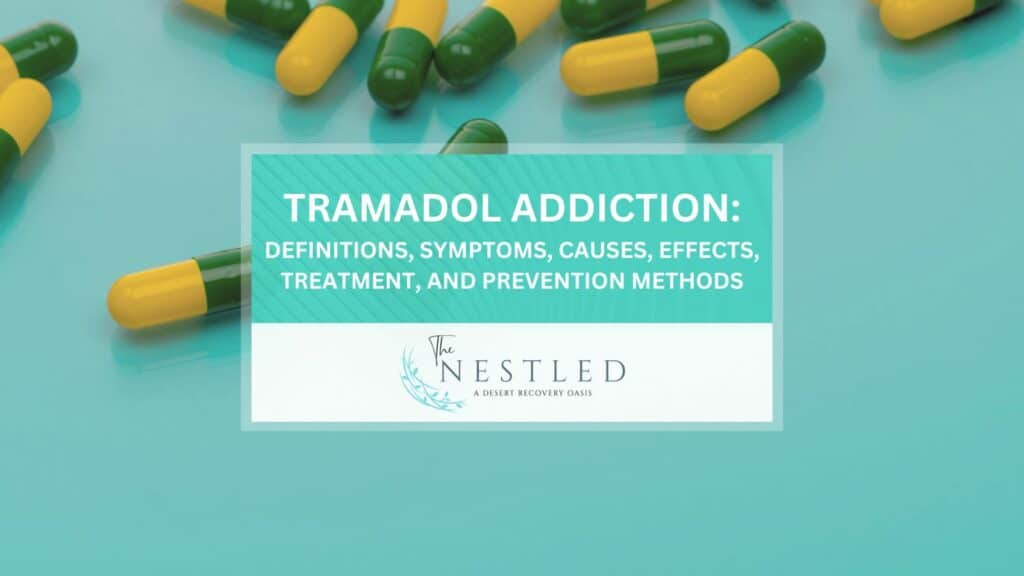Tramadol addiction is an intense urge to use the painkiller tramadol despite its negative consequences. Tramadol addiction is characterized by a dependency on tramadol, either psychological or physical.
Symptoms of tramadol addiction include an intense craving for the drug, inability to control usage, withdrawal symptoms in its absence, and persistent use regardless of negative impacts on health and lifestyle.
Causes of tramadol addiction include long-term usage, high dosages, and a genetic predisposition. Typically, tramadol addiction starts with a medical prescription for pain but grows to dependency as tolerance to the drug’s effects increases.
The effects of tramadol addiction vary from mild symptoms like drowsiness and confusion to severe health complications such as respiratory depression and significant hypotension.
Treatment for tramadol addiction involves a combination of medical detoxification, counseling, and support groups. Healthcare professionals often prescribe medications to alleviate withdrawal symptoms and reduce cravings.
Preventing tramadol addiction requires using the medication solely as prescribed, recognizing early signs of dependency, and education and awareness.
What Is Tramadol Addiction?
Tramadol addiction is a compulsive urge to use the drug tramadol despite its negative consequences to their health and well-being. Tramadol is an opioid often used as a painkiller. According to the National Survey on Drug Use and Health’s 2022 report, out of the 14.6 million people aged 12 and above who used tramadol products in the past year, 9.4% of these individuals misused the drug. Its opioid nature means it binds to particular receptors in the brain and nervous system to relieve pain, which can also produce feelings of euphoria and relaxation.
These pleasurable effects tend to lead some people to misuse tramadol. They take it in a manner or dose other than prescribed or without a prescription at all. Over time, users develop a tolerance, requiring more of the drug to achieve the same effects. This tolerance makes people physically and psychologically dependent on it.
What Are The Symptoms Of Tramadol Addiction?

Tramadol addiction manifests through 3 ranges of symptoms: physical, psychological, and social symptoms.
Physical Symptoms of Tramadol Addiction
- Increased Tolerance: Over time, addicted individuals need higher doses of tramadol to experience the same pain-relieving effects. The increased tolerance is a crucial indicator of physical dependence.
- Withdrawal Symptoms: When tramadol use is reduced or stopped, individuals addicted to it suffer from withdrawal symptoms, which include sweating, chills, nausea, vomiting, diarrhea, muscle aches, and insomnia.
- Changes in Physical Appearance: people addicted to tramadol experience neglect of personal grooming and weight loss due to changes in sleeping patterns.
- Drowsiness: Tramadol causes extreme drowsiness and lethargy as it depresses the central nervous system.
- Headaches: Frequent headaches occur both as a side effect of tramadol use and as a withdrawal symptom.
Psychological Symptoms of Tramadol Addiction
- Compulsive Drug-Seeking Behavior: A strong desire or urge to use tramadol, often going to great lengths to obtain and use the drug.
- Anxiety and Depression: Mood swings are expected, with addicted individuals often experiencing bouts of anxiety or depression.
- Impaired Cognitive Function: Prolonged tramadol use causes difficulty concentrating, confusion, and poor decision-making skills.
- Euphoria: While using tramadol, individuals experience moments of extreme happiness or well-being, which drives the compulsion to use the drug again.
Behavioral Symptoms of Tramadol Addiction
- Doctor Shopping: people addicted to tramadol spend time visiting multiple doctors to obtain more prescriptions for tramadol.
- Neglect of Responsibilities: Ignoring or failing to fulfill work, school, or home duties.
- Social Withdrawal: Tramadol-addicted individuals isolate themselves from family and friends. They lose interest in activities that were once enjoyed.
- Financial Issues: people with tramadol addiction spend significant amounts of money on tramadol, leading to financial distress.
- Legal Problems: Engaging in illegal activities, such as forging prescriptions or buying tramadol on the black market, may lead to legal issues.
What Are The Causes Of Tramadol Addiction?
Like most opioids, the causes of tramadol addiction are medical use, biological factors, psychological factors, environmental factors, and behavioral factors. These factors all contribute to the dependency on this opioid medication.
In their 2018 research titled “Postsurgical prescriptions for opioid naive patients and association with overdose and misuse: retrospective cohort study,” Brat GA and colleagues explain that opioid dependence and addiction result from a complex interplay of biological, environmental, genetic, and psychosocial factors.
Prescription And Medical Use
- Chronic Pain Management: Tramadol is often prescribed to manage moderate to moderately severe pain. However, regular, long-term use increases the risk of dependence, even when taken as directed by a doctor.
- Increased Dosage: Patients have a higher risk of developing tolerance, leading them to take higher doses to achieve the same pain-relieving effects. Increased tolerance leads to the development of addiction.
Biological Factors
- Genetics: There is evidence suggesting that genetics play a role in an individual’s proneness to tramadol addiction. Specific genetic variations affect how one’s body processes the drug. People with a history of drug abuse are more likely to get addicted to tramadol.
- Neurological Impact: Tramadol works by altering the brain’s perception of pain and increasing dopamine levels. It leads to feelings of well-being and pleasure, thus increasing the behavior of drug use.
Psychological Factors
- Mental Health Disorders: Individuals with mental health disorders are more likely to misuse tramadol as a means of self-medicating emotional pain.
- Stress and Emotional Distress: High levels of stress or emotional trauma increase the risk of addiction as individuals seek relief from their distress.
Social And Environmental Factors
- Accessibility and Availability: Easy access to tramadol, whether through prescriptions or illicit sources, increases the risk of developing an addiction.
- Social Influence: Peer pressure or living in an environment where drug use is common contributes to the initiation and continuation of tramadol use.
Behavioral Factors
- Recreational Use: Some individuals start using tramadol for its euphoric effects rather than for pain relief, which quickly leads to chronic use and addiction.
- Poor Coping Mechanisms: Using tramadol to cope with everyday stressors or emotional issues sets a pattern of misuse that escalates into addiction.
What Are The Effects Of Tramadol Addiction?
Tramadol addiction can have a wide range of effects, impacting physical health, mental well-being, and overall quality of life. According to DAILYMED, tramadol hydrochloride tablets expose patients and other users to the risks of opioid addiction, abuse and misuse, which can lead to overdose and death.
What Are The Physical Health Effects Of Tramadol Addiction?
Tramadol addiction affects its users physically in 5 ways;
- Prolonged use of tramadol leads to tolerance and dependence. The body starts needing higher doses to achieve the same effects. Worse, the body begins to need the drug to function normally.
- Tramadol addiction causes withdrawal symptoms such as nausea, shivering, sweating, anxiety, depression, and severe cravings, making it difficult to quit.
- Tramadol addiction increases the risk of overdose, which is fatal. Symptoms of overdose include severe drowsiness, slow heartbeat, cold and clammy skin, very slow breathing, or coma.
- Prolonged tramadol use leads to seizures, especially at high doses or when interacting with other medications. Beyaz, Serbülent G. et al’s 2016 study, tramadol triggers seizure activity in its users, but the exact dosage is still being researched.
- Long-term abuse harms the liver and kidneys, potentially leading to chronic conditions or failure of these organs.
What Are The Mental Health Effects Of Tramadol Addiction?
The Mayo Clinic states that when tramadol is used for a long time, it causes mental dependence.
- People addicted to tramadol often experience cognition impairment, poor memory, decision-making, and problem-solving.
- The use of tramadol worsens or leads to new mood disorders, such as depression or anxiety, mainly due to its effects on brain chemistry.
- People with tramadol addiction tend to become emotionally reliant on tramadol. They feel unable to cope with everyday life without the drug.
What Are The Social and Behavioral Consequences Of Tramadol Addiction?
Tramadol addiction can lead to various social and behavioral consequences that disrupt the user’s life and relationships.
- Tramadol addiction increases the chance of relationship strain due to erratic behavior, neglect, and the prioritization of drug use over social responsibilities.
- The cost of obtaining tramadol to serve an addiction leads to financial strain or legal problems.
- Tramadol addiction decreases performance at work or school, increases absenteeism, and possibly job loss.
- Legal issues often arise from activities such as doctor shopping, prescription forgery, or illegal possession and use of tramadol.
What Are The Treatment Strategies For Tramadol Addiction?
The American Addiction Centers lists the common levels of care for tramadol addiction as detox, inpatient and outpatient treatment, and aftercare programs. Each stage addresses different aspects and intensities of addiction, providing a comprehensive approach to recovery.
Medical Detoxification
This first step in treating tramadol addiction involves medically supervised detoxification. Detoxification is a supervised medical withdrawal from tramadol. It is used to manage the acute physical symptoms of drug stops safely. Medical professionals administer medications to ease withdrawal symptoms, reduce cravings, and prevent potential complications such as seizures.
- Medication-Assisted Treatment (MAT)
Certain medications stabilize brain chemistry, reduce cravings, and treat co-occurring disorders. Common medications include methadone, buprenorphine, and naltrexone. These help moderate brain function and decrease the physiological reliance on tramadol.
If the addiction co-occurs with mental health disorders like depression or anxiety, these conditions are treated together with appropriate medications and therapies.
- Behavioral Therapies
- Cognitive Behavioral Therapy (CBT): This therapy helps patients understand the thoughts and situations that lead to drug use. It helps addicted individuals to develop healthier thinking patterns and learn ways to manage stress and avoid relapse.
- Contingency Management: This behavioral therapy type provides rewards for maintaining sobriety and achieving treatment milestones. The rewards aim to motivate patients to stay drug-free.
- Motivational Interviewing: motivational interviewing increases an individual’s motivation to change behavior and engage in treatment.
- Support Groups And Peer Support
Support groups offer a structured program that involves admitting powerlessness over addiction, finding a higher power, and making amends for past behavior. These groups can be secular, science-based, or religious-based, but they all focus on self-empowerment and self-reliance.
- Lifestyle Changes And Holistic Therapies
- Exercise and a healthy diet improve mood, reduce stress, and enhance overall health, which are vital for recovery.
- Mindfulness and Meditation practices help manage stress and emotions, reducing the likelihood of relapse.
What Are The Prevention Methods For Tramadol Addiction?
The prevention methods for tramadol addiction are:
- Prescription monitoring
- Educating patients and healthcare providers
- Setting strict regulations for prescribing
- Providing alternative pain management options
- Raising awareness about the risks of addiction
- Implementing early intervention strategies
- Monitoring for signs of misuse and addiction
- Supporting mental health and stress management
- Ensuring access to addiction treatment and support services
How can healthcare providers screen for potential tramadol and inhalant addiction during routine medical visits?
Healthcare providers can screen for potential tramadol and inhalant addiction during routine medical visits by incorporating specific questions and assessments into their practice. For tramadol, providers can review prescription histories, ask about pain management practices, and look for signs of misuse, such as requesting early refills or displaying withdrawal symptoms. For inhalant addiction, providers can inquire about unusual symptoms like frequent headaches, nosebleeds, or chemical odors on the breath, and ask about behaviors that may indicate inhalant use. Screening tools like questionnaires and brief interviews can help identify at-risk individuals.
How Long Does It Take To Become Addicted To Tramadol?
The time it takes to become addicted to tramadol varies significantly among individuals, depending on factors like dosage, frequency of use, and personal health history. Addiction often develops within a few weeks of daily use.
What role does early education play in preventing tramadol addiction and nicotine addiction among teenagers?
Early education plays a crucial role in preventing both tramadol and nicotine addiction among teenagers by raising awareness about the risks and consequences of substance abuse. Educational programs in schools can provide information about the dangers of prescription drug misuse and the addictive nature of nicotine, emphasizing the long-term health consequences. Interactive and engaging methods, such as peer-led discussions and real-life testimonials, can make the information more relatable and impactful. By equipping teenagers with knowledge and skills to resist peer pressure and make informed decisions, early education can significantly reduce the incidence of tramadol and nicotine addiction.
Is Tramadol Addiction Dangerous?
Yes, tramadol addiction is dangerous. It leads to severe physical and psychological health issues, overdose, and even death, especially when mixed with other substances.
Can You Overcome Tramadol Addiction Without Professional Help?
Overcoming tramadol addiction without professional help is challenging and not generally recommended due to withdrawal symptoms and the high risk of relapse. Professional treatment programs provide the necessary support for effective and safe recovery.

Share This Post




